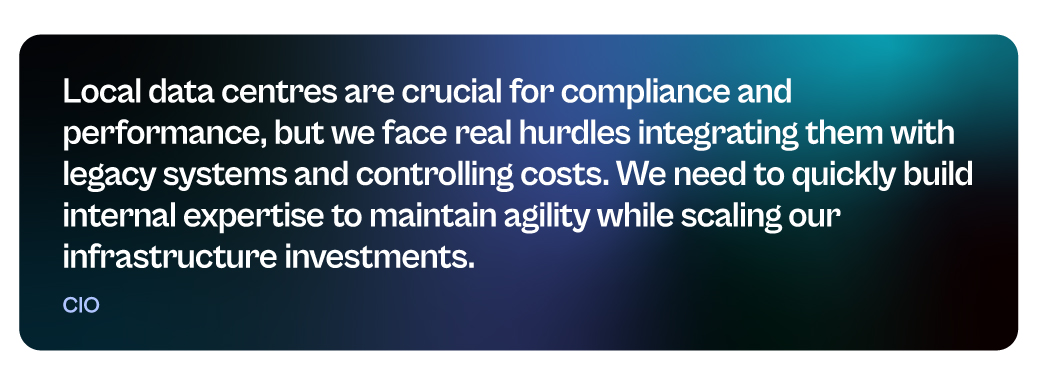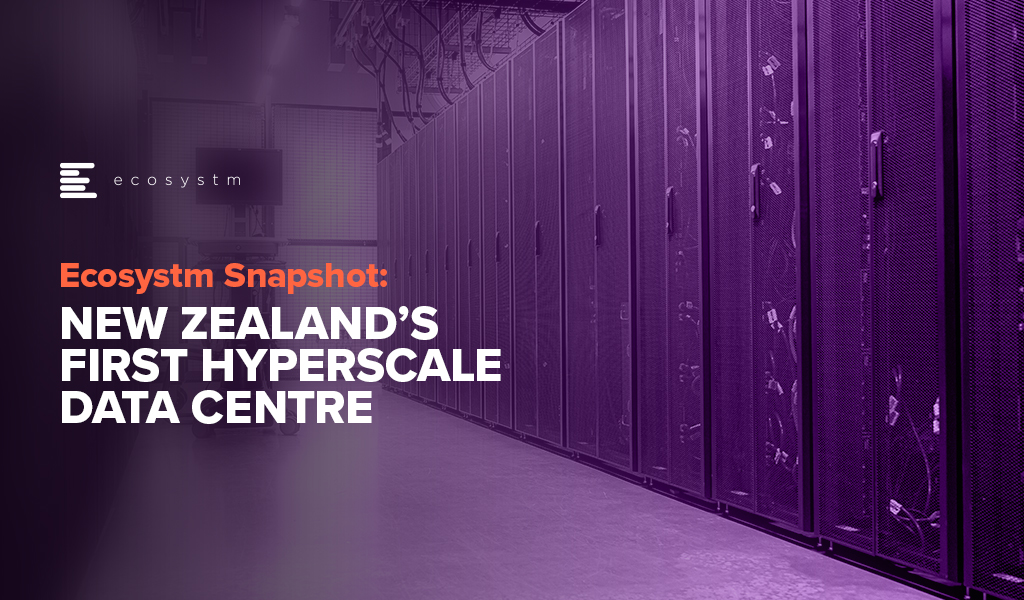India’s rapid digital growth is driven by a unique blend of scale, public infrastructure, and entrepreneurial spirit. The focus is shifting from simply widening access to creating systems that are inclusive, adaptable, and built to last.
What sets India apart is its reliance on open digital platforms tailored to local needs, supported by a mix of government involvement and private-sector innovation. Whether it’s developing multilingual AI, leading product creation for global markets, advancing digital public goods, or pursuing sovereign cloud strategies, India is forging a path shaped by its diversity and growing self-assurance.
Based on Ecosystm’s roundtables and research across India, a distinctive digital model is emerging – one designed to navigate uneven challenges, grounded in practical solutions, and increasingly shaping conversations beyond its borders.
Here are five signals that capture the pulse of India’s digital journey in 2025.
1. Global Design, Local Disruption: The GCC-Driven Tech Surge in India
India’s Global Capability Centres (GCCs) have evolved far beyond their origins as cost-efficient outposts for multinational firms. In 2025, with over 1,600 centres spread across Bengaluru, Hyderabad, Pune, and beyond, GCCs are now designing digital products, AI copilots, and cybersecurity frameworks from the ground up. This transformation is not just redefining global enterprise workflows, it’s reshaping India’s own tech landscape.
As GCCs prototype cutting-edge tools for global banks, retailers, and healthcare systems, their proximity to India’s broader business ecosystem is creating powerful ripple effects. Local startups, mid-sized firms, and even traditional industries are gaining early access to best-in-class practices, technologies, and talent. For example, an AI-driven analytics platform developed for a US-based insurer may be adapted by a healthtech startup in Chennai within months, compressing tech adoption cycles and raising the digital maturity bar across sectors.

This fusion of global exposure and local relevance is accelerating India’s journey toward becoming a product and innovation powerhouse. As GCCs take on more strategic roles, their impact is no longer confined to their parent companies; they’re catalysing a wave of tech-enabled transformation across India’s broader economy.
2. The DPI Effect: Building Smarter, Scaling Faster in India’s Digital Economy
India’s Digital Public Infrastructure (DPI) is quietly powering one of the most inclusive and large-scale technology transformations in the world. While many countries depend on private platforms to deliver digital services, India has taken a distinctly public-first approach – building an open, interoperable digital stack designed for accessibility and scale. With Aadhaar (for identity), UPI (for payments), DigiLocker (for documentation), and the Account Aggregator framework (for secure data sharing) forming its backbone, DPI is not just a convenience but a catalyst for financial inclusion, health access, and rural entrepreneurship.
What sets India’s DPI apart is its dual impact. It empowers citizens while simultaneously accelerating tech adoption across Indian organisations. Enterprises – public and private – are reimagining service delivery, modernising workflows, and launching new offerings by plugging directly into these digital rails. MSMEs use UPI to streamline payments; insurers tap into Account Aggregator for personalised risk assessment; banks leverage Aadhaar for instant customer onboarding. As a result, digital-first operations are no longer limited to tech companies but extends to more traditional businesses.
The shift is as much cultural as it is technical. With trusted public infrastructure in place, startups and enterprises are building with greater confidence and speed, shortening go-to-market cycles and expanding reach. The Open Network for Digital Commerce (ONDC), for example, is enabling kirana stores and small businesses to participate in e-commerce without relying on proprietary platforms, levelling the playing field and accelerating digital inclusion from the ground up.

Global institutions like the World Bank and G20 are now taking note, studying how India’s model blends inclusion, scale, and innovation. In a fragmented digital world, India is showing that public infrastructure can enable private-sector agility and act as a force multiplier for enterprise tech adoption, from startups to state utilities.
3. From Pilots to Performance: India’s Shift Toward Scalable AI Impact
India’s AI journey is entering a critical inflection point. While 76% of organisations now view AI as essential to business success, only 23% have a clear roadmap to implement it, according to Ecosystm research. The gap is no longer about awareness; it’s about execution.
Many Indian enterprises are discovering that without defined outcomes, leadership commitment, and long-term investment in infrastructure and talent, AI efforts stall at the pilot stage. This realisation is shifting focus from experimentation to impact. Forward-looking organisations are starting to anchor AI to core business goals, measuring outcomes in terms of time saved, cost avoided, and revenue generated.

This strategic shift has major implications for India’s tech ecosystem. AI maturity will demand stronger collaboration across product, data, and operations teams; alongside an ecosystem of partners offering open, interoperable, and scalable solutions. It also presents a significant opportunity for Indian tech providers, startups, and systems integrators to support enterprise AI with domain-specific solutions, responsible AI practices, and robust infrastructure capabilities.
4. More Than Translation: India’s AI Accessibility Challenge
While much of the world debates whether AI can code, drive, or write like a human, India is asking a different question: can AI understand and respond like an Indian? With 22 official languages and hundreds of dialects, language is fundamental to access. That’s why India is placing early bets on vernacular AI. Government-led initiatives like Bhashini, under MeitY, are building an open language stack comprising Indic NLP models, regionally sourced datasets, and speech tools optimised for rural and low-literacy users.
This is starting to reshape how Indian organisations design digital experiences. Government services like MyGov and ONDC Saarthi now offer voice-first, multilingual interfaces. Startups such as Reverie, Lokal, and Sarvam are experimenting with models in languages like Hindi, Tamil, and Bengali to power regional content and customer support. The Krutrim LLM, launched recently, represents a step forward, an LLM model trained on Indian data and designed with cultural nuance in mind.
Yet the road ahead isn’t without hurdles. Data sparsity in low-resource languages, the complexity of dialectal variation, and limited commercial incentives for deep vernacular support remain real challenges.

India’s AI journey is being shaped by local priorities, where the next 500 million users coming online will rely more on voice, video, and vernacular than on text or English. That shift is forcing organisations to rethink how they train and deploy AI. The promise is real, but unlocking its full potential will require sustained investment, collaboration, and a deep understanding of linguistic diversity at scale.
5. Building India’s Digital Backbone: The Rise of Local Data Centres
Behind every AI application, mobile transaction, or video stream is a critical but often invisible layer: digital infrastructure. India is currently experiencing one of its largest data centre expansions, with capacity expected to nearly double from around 950 MW today to 1.8 GW by 2026. This growth is driven by rising cloud adoption, data localisation mandates, and increasing demand for AI training and inference within the country.
Companies such as Yotta, AdaniConneX, and Jio are developing hyperscale campuses in Mumbai, Chennai, and Hyderabad, while some state governments are partnering with international firms to build AI-ready, energy-efficient data centres.
For organisations, this expanding infrastructure promises faster access to cloud and AI capabilities, improved latency for critical applications, and compliance with data localisation rules. For organisations, this expanding infrastructure promises faster access to cloud and AI capabilities, improved latency for critical applications, and easier compliance with data localisation rules. However, many face challenges in fully leveraging this growth – navigating the complexity of integrating new infrastructure with legacy systems, managing higher operational costs, and building the in-house expertise required to optimise AI workloads locally.

As India pushes for greater digital sovereignty and infrastructure resilience, the expansion of local data centres will be a crucial factor shaping how organisations innovate and compete in the AI era. Yet realising this potential will require addressing operational challenges alongside building scale.
Designing for Complexity, Delivering for Scale
The future of India’s digital landscape hinges on its ability to convert scale and innovation into sustained, inclusive impact. This requires organisations to move beyond experimentation, integrating new technologies deeply, overcoming legacy constraints, and building local expertise at pace. The race is no longer just about access or capability; it’s about agility, resilience, and leadership in a rapidly evolving global tech environment. How India navigates these challenges will determine whether it merely participates in the digital era or defines it.

New Zealand’s cloud landscape is looking to change drastically with the arrival of its first hyperscale data centre platform in Invercargill, a city in the southern tip of New Zealand’s South Island. The focus on digitalisation (in both the private and public sectors), growing data localisation mandates, the need for big data storage, and the demand for scalable apps and innovations are driving the demand for hyperscale data centres and more undersea cables in the region.
In December 2020, Meridian Energy, New Zealand’s fourth-largest electricity retailer, and Datagrid New Zealand, run by Hawaiki Cable announced the launch of the project to develop a 60MW, 25,000 sqm facility near the town of Makarewa at a cost of nearly USD 500 million. The project is due for a commercial launch in 2023, and a major part of the investment will involve the laying of two new submarine cables. The first subsea cable will connect Invercargill to Sydney and Melbourne in Australia and the second will connect with Hawaiki Cable’s landing point at Mangawhai Heads, north of Auckland which will further extend to Auckland, Wellington, and Christchurch.
The country clearly recognises the need for a robust infrastructure to accelerate innovation – Microsoft has also received approval from the New Zealand government in September last year to open a data centre region. To support the future of cloud services and to fulfil New Zealand progressive data centre demands, CDC Data Centres have also planned to develop two new hyperscale data centres in Auckland, New Zealand.
Ecosystm Comments

“The introduction of the Datagrid New Zealand data centre in Invercargill will be a welcome asset to the Southland region of New Zealand. With primary industries being farming, fishing and forestry, the region has done well throughout the COVID-19 pandemic. This initiative will further benefit the local economy by delivering opportunities for economic prosperity for local businesses.
With long-term growth at the data centre expected to consume up to 100MW of renewable energy, Meridian Energy is well equipped to provide renewable energy generated at the Manapouri hydroelectric power station, capable of generating 850MW. The potential closure of the 550MW Tiwai Point Aluminium Smelter is expected to put the country in a position of oversupply.
The data centre will be a critical piece of New Zealand’s infrastructure, supporting the roll-out of 5G networks by telecom providers and the need for low-latency cloud compute and data storage. Datagrid will provide a competitive alternative to the likes of Microsoft’s new data centre.
While the construction and opening of the data centre will possibly add more stress to New Zealand’s under-resourced construction sector, it will also create tech jobs in the Southland region, in the long term. Unique to the region is the Southern Institute of Technology that has a Zero Fees Scheme that has been confirmed until the end of 2022. The data centre will help to keep skilled tech workers in the region.“
Identifying emerging cloud computing trends can help you drive digital business decision making, vendor and technology platform selection and investment strategies.Gain access to more insights from the Ecosystm Cloud Study.




